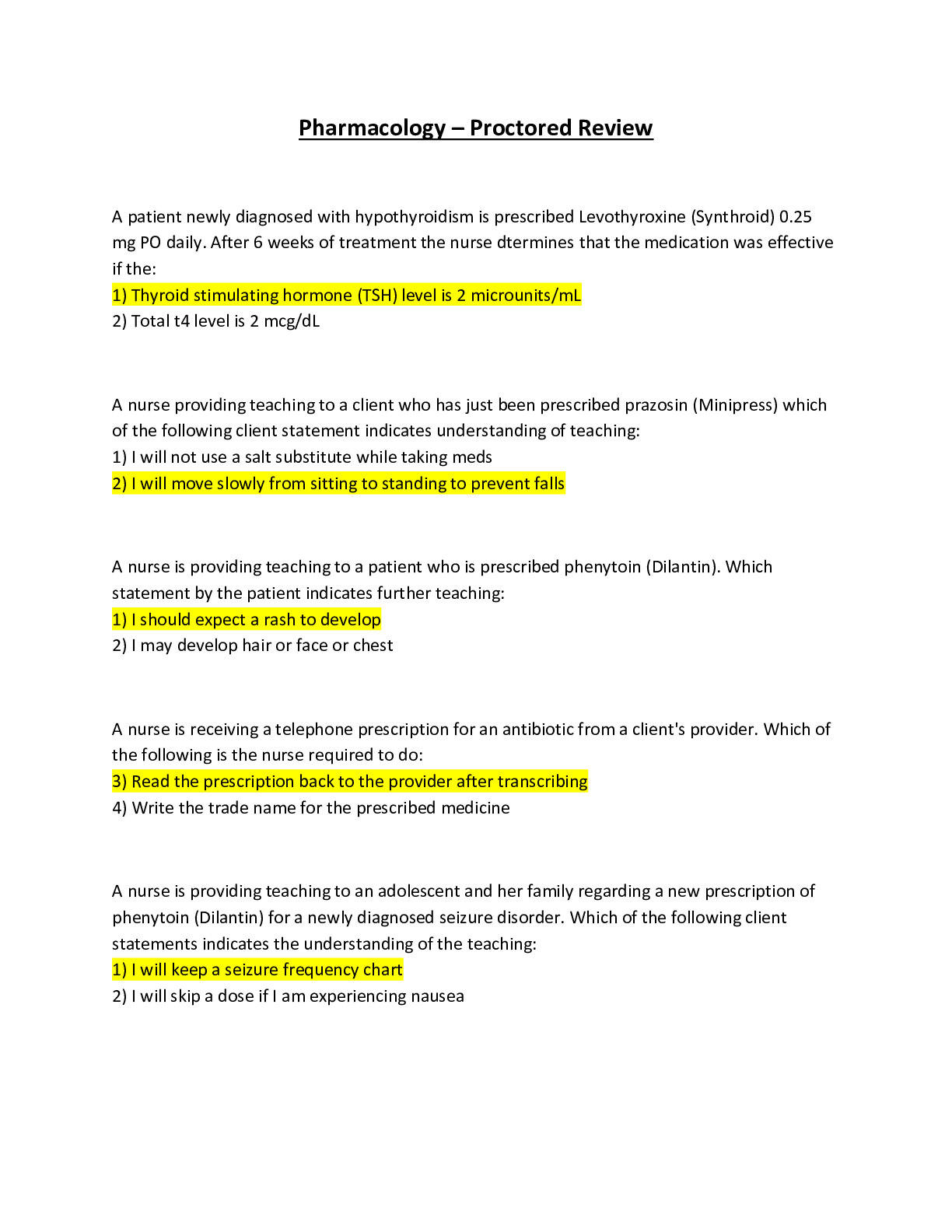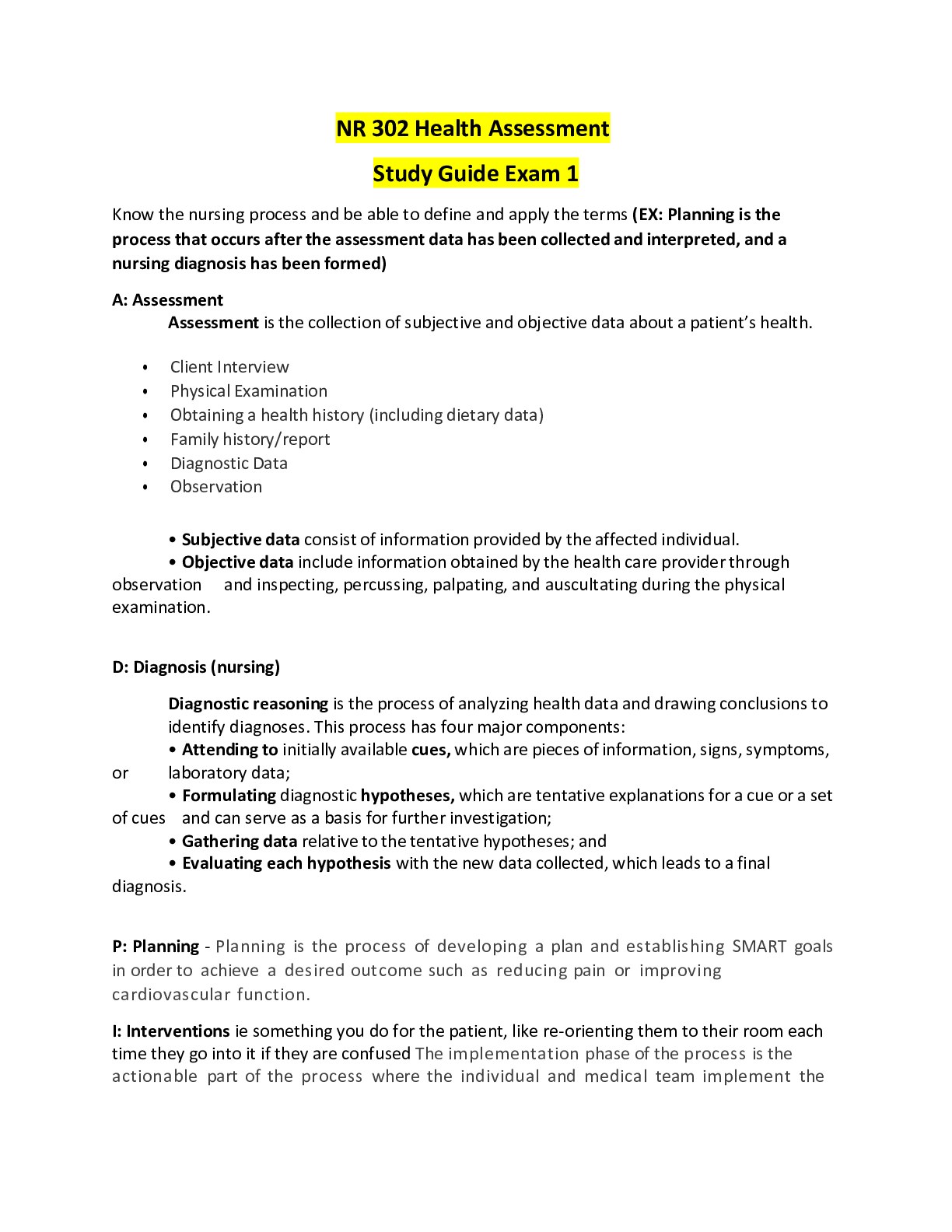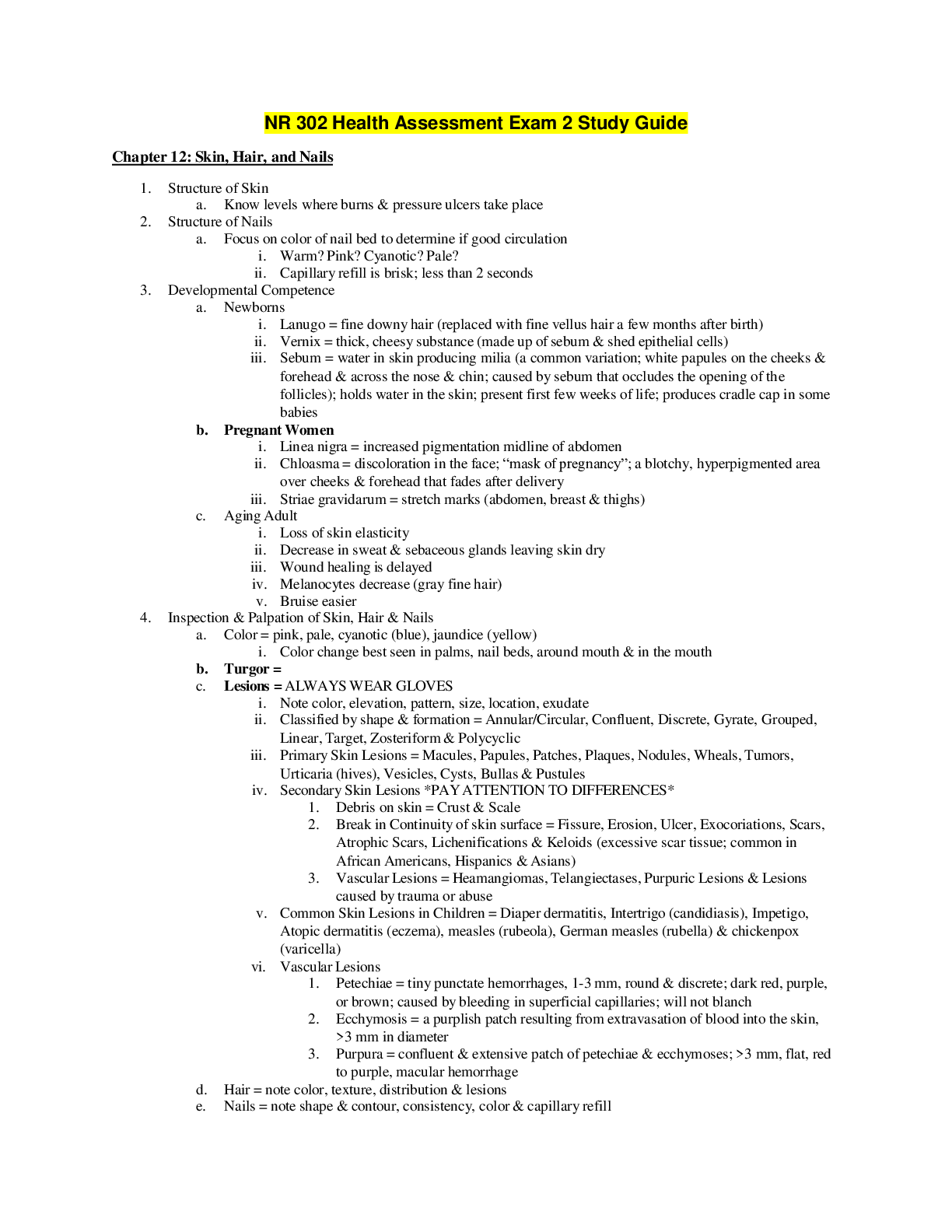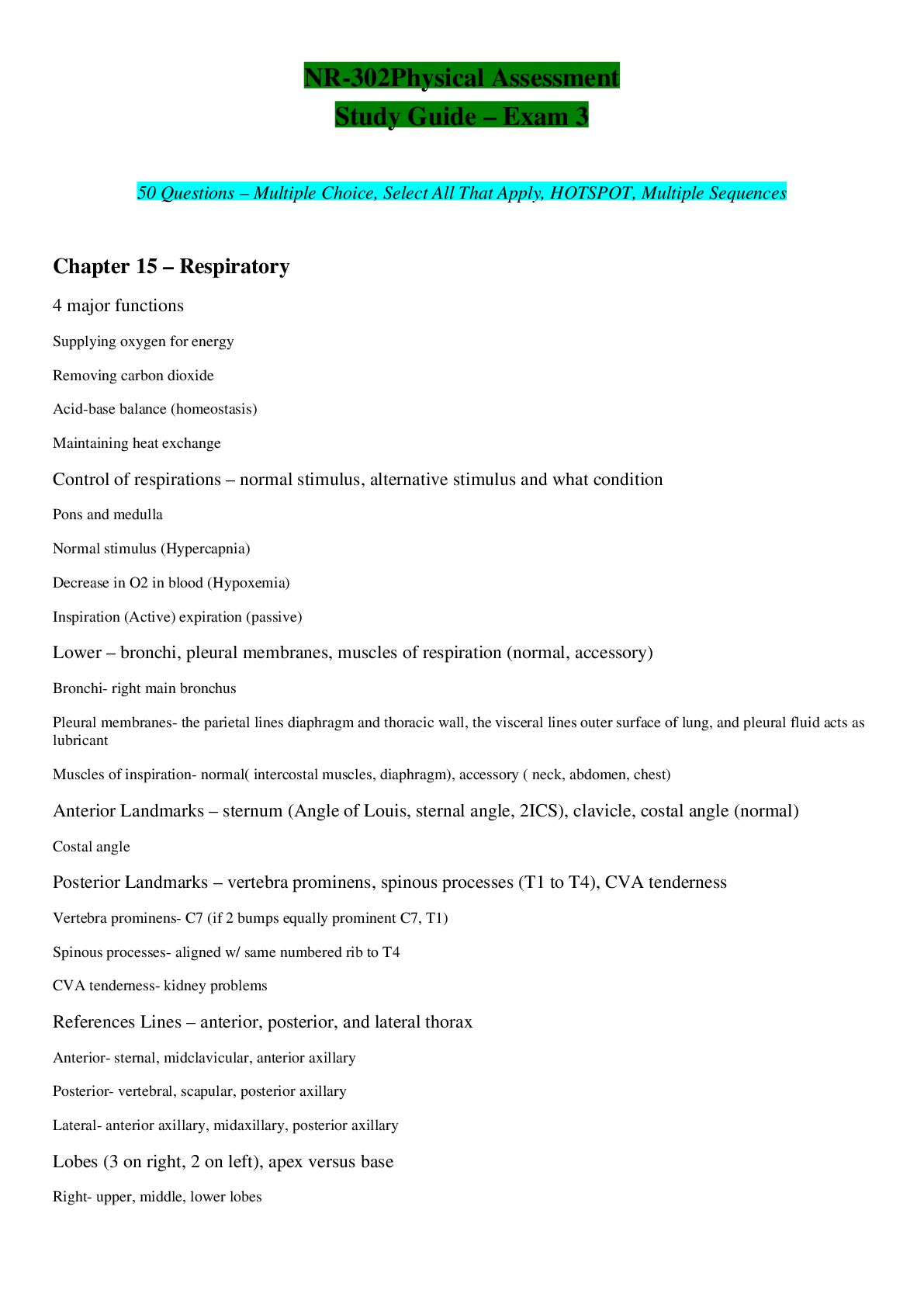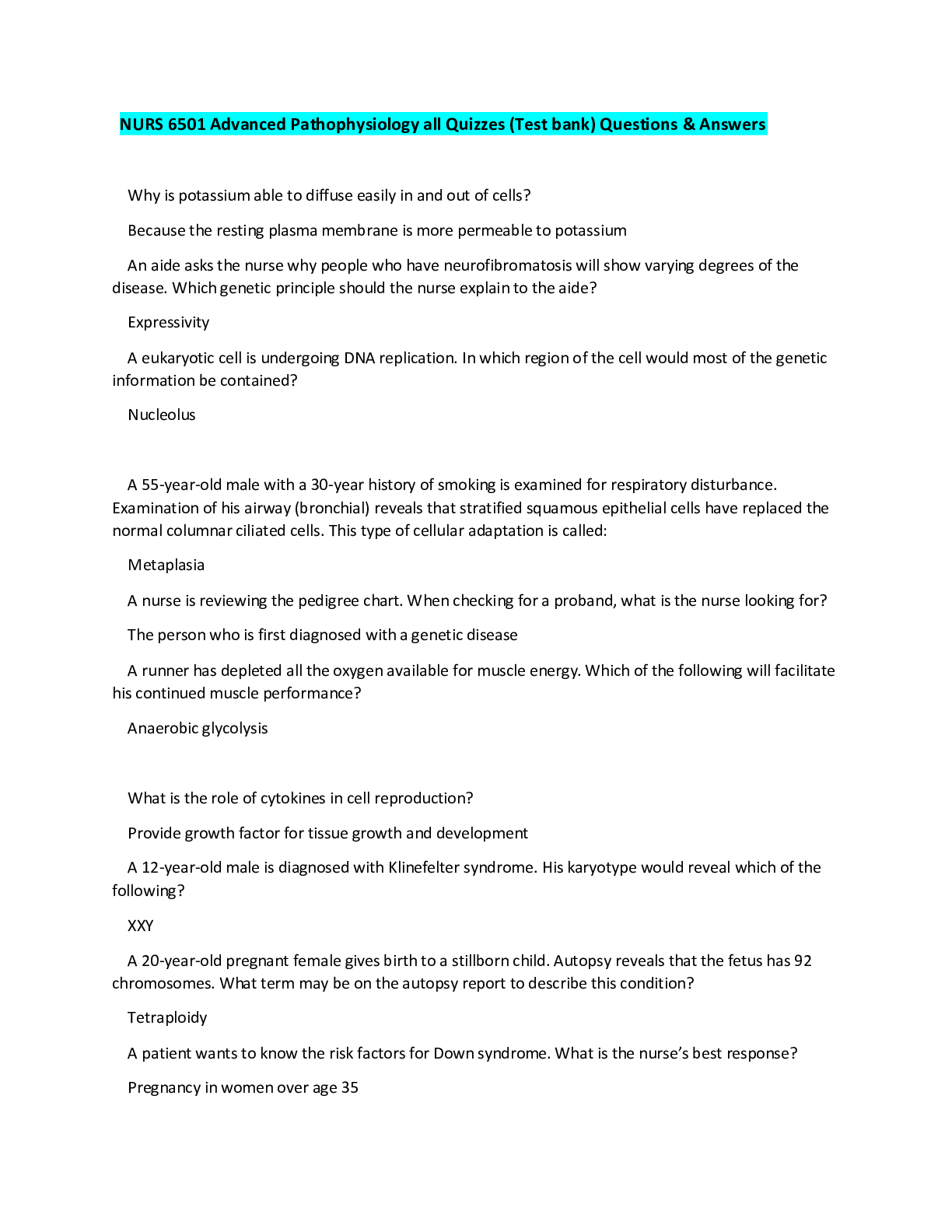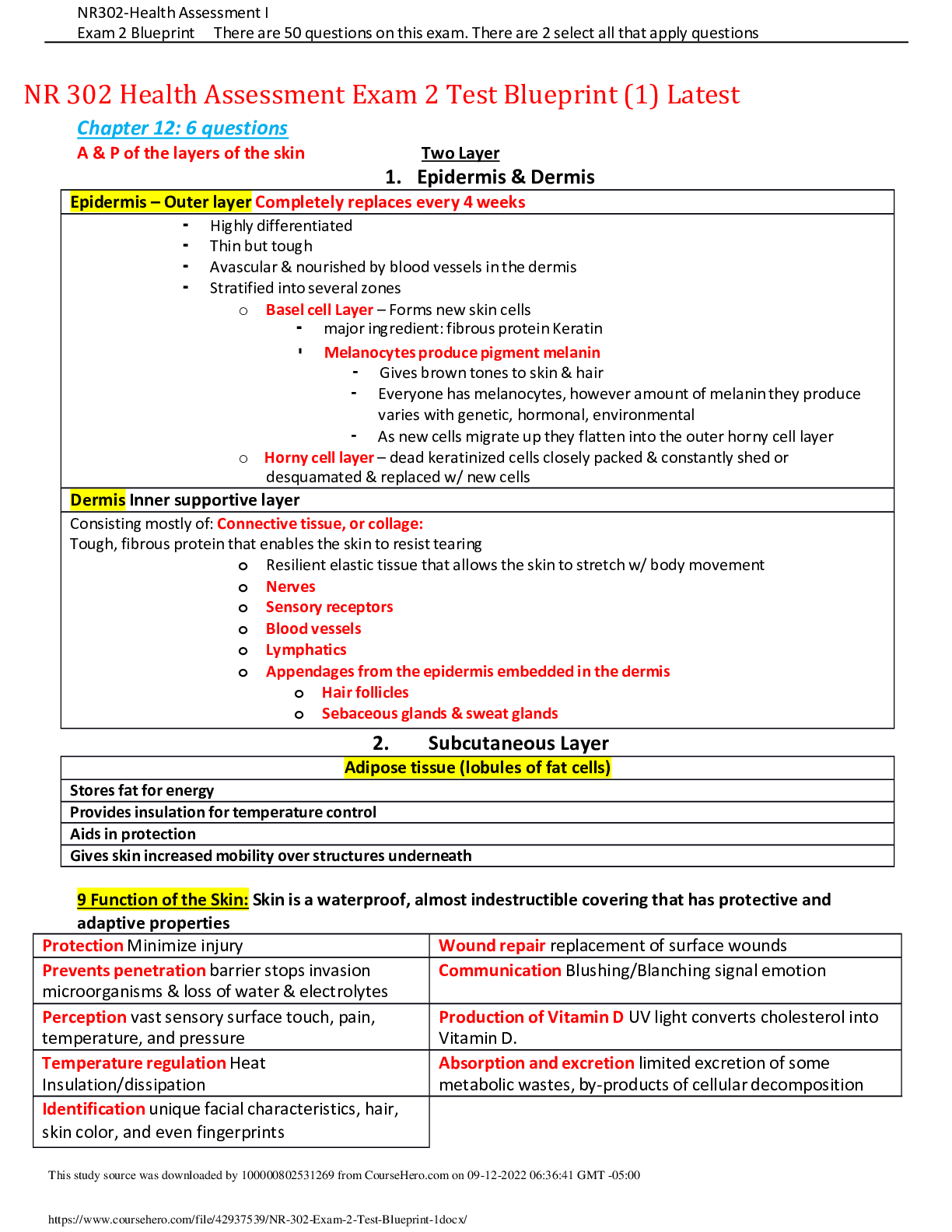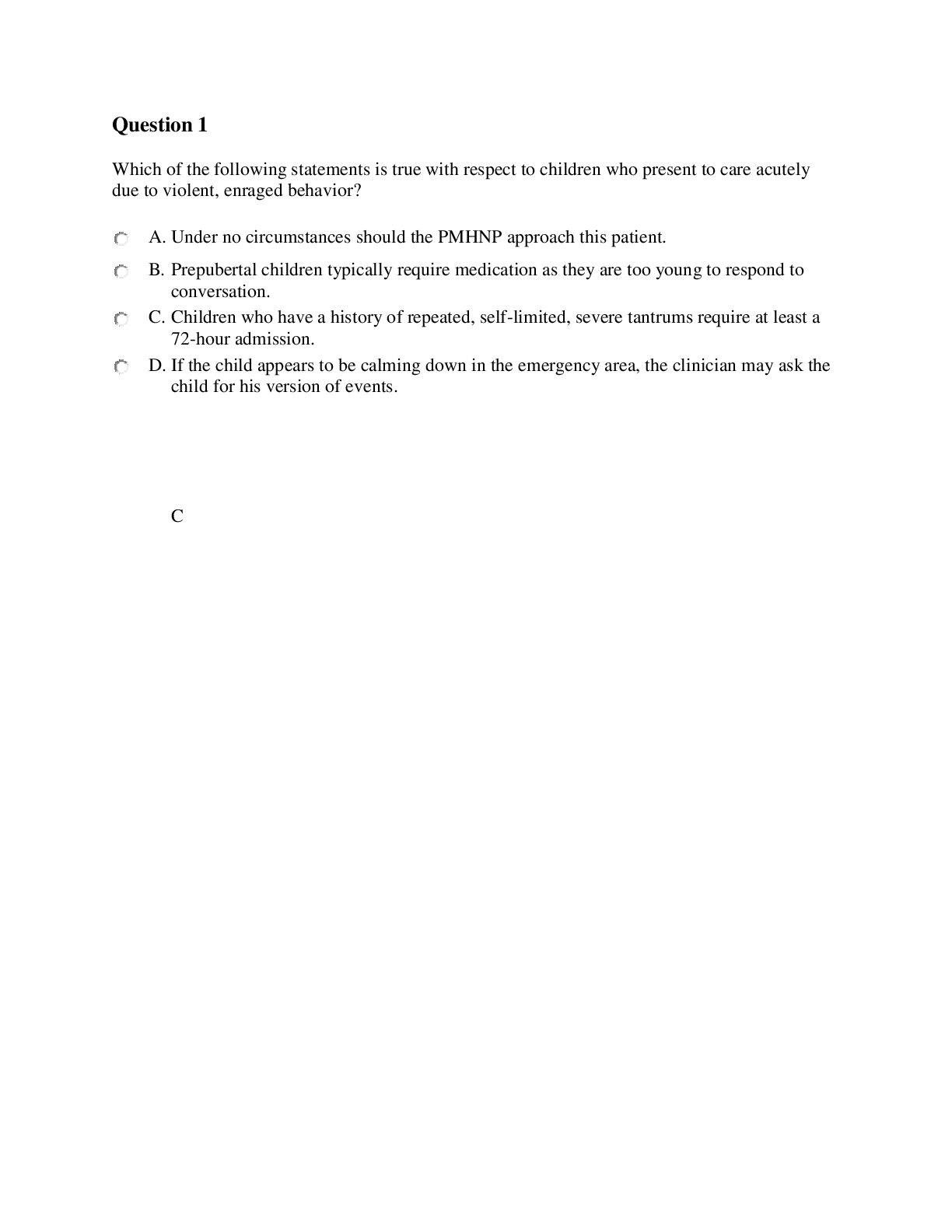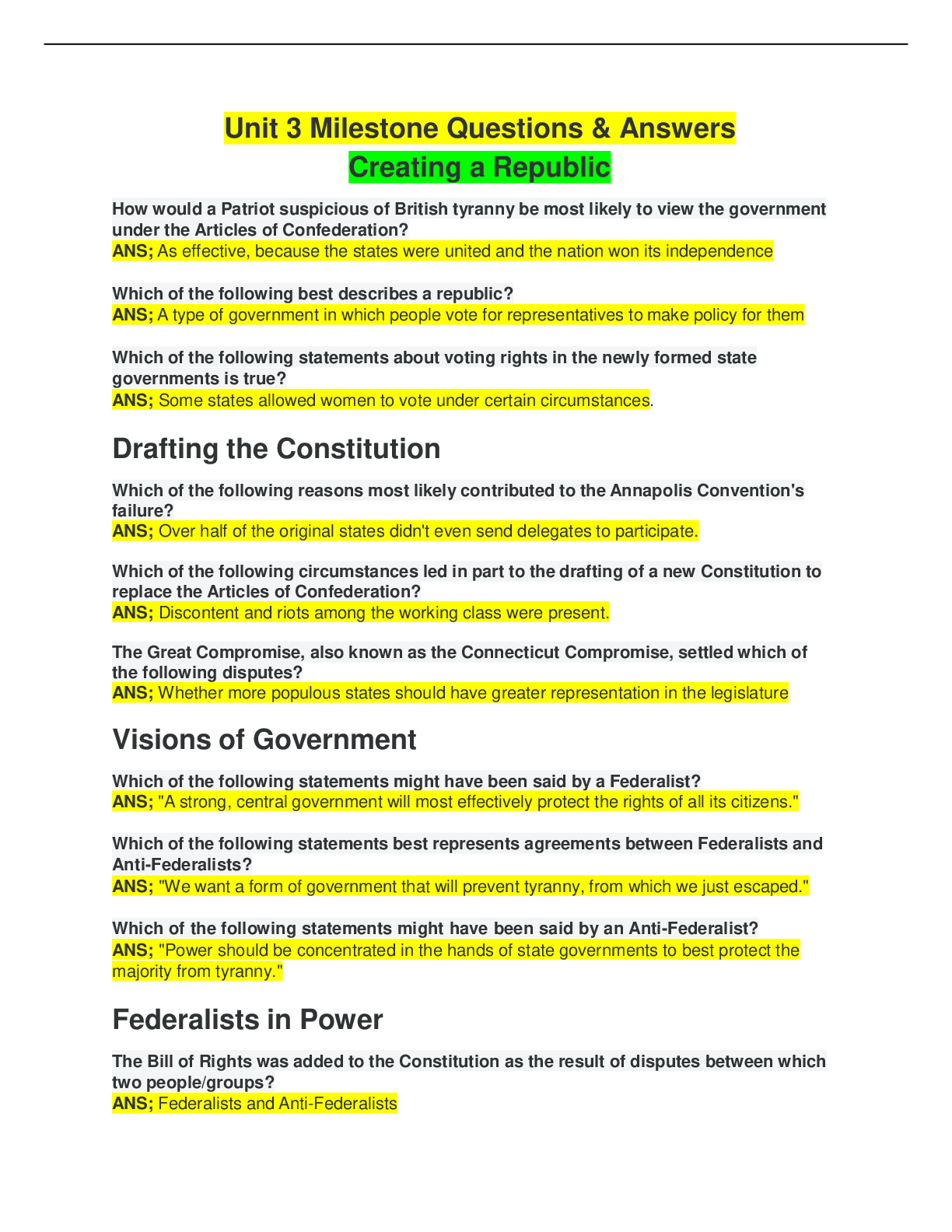*NURSING > EXAM > HEALTH ASS NR 302 Exam 1 Evolve Questions & Answers Latest updated,100% CORRECT (All)
HEALTH ASS NR 302 Exam 1 Evolve Questions & Answers Latest updated,100% CORRECT
Document Content and Description Below
HEALTH ASS NR 302 Exam 1 Evolve Questions & Answers Latest updated Chapter 1 1. An example of subjective data is: a. Decreased range of motion b. Crepitation in the left knee joint c. Lef t k... nee has been swollen and hot for the past 3 days d. Arthritis 2. An example of objective data is: a. A complaint of left knee pain b. Crepitation in the lef t knee joint (assessed by palpation) c. Left knee has been swollen and hot for the past 3 days d. A report of impaired mobility from left knee pain as evidenced by an inability to walk, swelling, and pain on passive range of motion 3. Which of the following is an example of objective data? a. Alert and oriented b. Dizziness c. An earache d. A sore throat 4. A complete database is: a. Used to collect data rapidly and is often compiled concurrently with lifesaving measures b. Used for a limited or short-term problem usually consisting of one problem, one cue complex, or one body system c. Used to evaluate the cause or etiology of disease d. Used to perform a thorough or comprehensive health history and physical examination 5. What type of database is most appropriate when rapid collection of data is required and often compiled concurrently with lifesaving measures? a. Episodic b. Follow-up c. Emergency d. Complete 6. A nursing diagnosis is best described as: a. a determination of the etiology of disease b. a pattern of coping c. an individual’s perception of health d. a concise statement of actual or potential health concerns or level of wellness 7. What type of database is most appropriate for an individual who is admitted to a long-term care facility? a. Episodic b. Follow-up c. Emergency d. Complete 8. A patient admitted to the hospital with asthma has the following problems identified based on an admission health history and physical assessment. Which problem is a first-level priority? a. Ineffective self-health management b. Risk for infection c. Impaired gas exchange d. Readiness for enhanced spiritual well-being 9. A medical diagnosis is used to evaluate: a. A person’s state of health b. The response of the whole person to actual or potential health problems c. A person’s culture d. The cause of disease 10. According to the holistic model, a narrow definition of holistic health includes: a. an optimal functioning of mind, body, and spirit within the environment b. the absence of disease c. the response of the whole person to actual or potential problems d. the internal and external environment Chapter 2 1. On the basis of median age: a. the non-Hispanic white population tends to be younger b. the Hispanic population tends to be older c. the Asian population tends to be younger d. minorities tend to be older than non-Hispanic white populations 2. What is the yin/yang theory of health? a. Health exists when all aspects of the person are in perfect balance b. Health exists when physical, psychological, spiritual, and social needs are met c. Health exists in the absence of illness d. Health exists when there is optimal functioning 3. While evaluating the health history, the nurse determines that the patient subscribes to the hot/cold theory of health. Which of the following would most likely describe this patient’s view of wellness? a. Good is hot b. Evil is hot c. The humors must be balances d. The phlegm will be replaced with dryness 4. Spirituality is defined as: a. participating in religious services on a regular basis b. a personal effort to find meaning and purpose in life c. the process of being raised within a culture d. a social group that claims to possess variable traits 5. Which theory has been expanded in an attempt to study the degree to which a person’s lifestyle reflects his or her traditional heritage? a. Behavior theory b. Heritage consistency c. Congruence mechanism d. Socialization experience 6. Each culture has its own healers who usually: a. speak at least two languages b. own and operate specialty community clinics c. cost less than traditional or biomedical providers d. recommend folk practices that are dangerous 7. Which of the following statements regarding language barriers and health care is true? a. There is a law that addresses language barriers and health care b. Limited English proficiency is associated with a higher quality of care c. English proficiency is associated with a lower quality of care d. Patients with language barriers have a decreased risk of nonadherence to medication regimens 8. When considering cultural competence, the nurse must develop knowledge of discrete areas to understand the health care needs of others. These discrete areas include understanding of: a. His or her own heritage b. Cultural and ethnic values c. The heritage of the nursing profession d. The heritage of the patient e. The heritage of the health care system 9. Which of the following symptoms is greatly influenced by a person’s cultural heritage? a. Hearing loss b. Pain c. Breast lump d. Food intolerance Chapter 3 1. The use of euphemisms to avoid reality or to hide feelings is known as: a. Distancing language b. Sympathetic language c. Avoidance language d. Ethnocentric language 2. While discussing the treatment plan, the nurse infers that the patient is uncomfortable asking the physician for a different treatment because of fear of the physician’s reaction. In this situation, the nurse’s verbal interpretation: a. affects the nurse-physician relationship b. impedes further discussion c. helps the patient understand personal feelings in relation to his or her verbal message d. helps the nurse understand his or her own feelings in relation to the patient’s verbal message 3. Which of the following statements made by the interviewer would be an appropriate response? a. “I know just how you feel.” b. “If I were you, I would have the surgery.” c. “Why did you wait so long to make an appointment?” d. “Tell me what you mean by ‘bad blood.’” 4. When preparing the physical setting for an interview, the interviewer should: a. set the room temperature between 64° F and 66° F b. reduce noise by turning the volume on the television or radio down c. conduct the interview at eye level and at a distance of 4 to 5 feet d. stand next to the patient to convey a professional demeanor 5. Parents or caretakers accompany children to the health care setting. Starting at years of age, the interviewer asks the child directly about his or her presenting symptoms. a. 5 b. 7 c. 8 d. 11 6. Nonverbal communication is the primary form of communication for which group of individuals? a. Infants b. Preschoolers c. Adolescents d. Older adults 7. Viewing the world from another person’s inner frame of reference is called: a. Reflection b. Empathy c. Clarification d. Sympathy 8. When addressing a toddler during the interview, the health care provider should: a. Ask the child, before the caretaker, about symptoms b. Use nonverbal communication c. Use short, simple, concrete sentences d. Use detailed explanations 9. The most appropriate introduction to use to start an interview with an older adult patient is: a. “Mr. Jones, I want to ask you some questions about your health so that we can plan your care.” b. “David, I am here to ask you questions about your illness; we want to determine what is wrong.” c. “Mr. Jones, is it okay if I ask you several questions this morning about your health?” d. “Because so many people have already asked you questions, I will just get the information from the chart.” 10. An example of an open-ended question or statement is: a. “Tell me about your pain.” b. “On a scale of 1 to 10, how would you rate your pain?” c. “I can see that you are quite uncomfortable.” d. “You are upset about the level of pain, right?” Chapter 4 1. The nurse questions the reliability of the history provided by the patient. One method to verify information within the context of the interview is to: a. review previous medical records b. rephrase the same questions later in the interview c. ask the patient if there is someone who could verify information d. call a family member to confirm information 2. Which of the following is included in documenting a history source? a. Appearance, dress, and hygiene b. Cognition and literacy level c. Documented relationship of support systems d. Reliability of informant 3. PQRSTU is a mnemonic that helps the clinician to remember to address characteristics specific to: a. Severity of dementia b. Substance use and abuse c. Pain presentation d. The ability to perform activities of daily living (ADLs) 4. When taking a health history from an adolescent, the interviewer should: a. ask about violence and abuse before asking about alcohol and drug use b. have at least one parent present during the interview c. interview the youth alone with a parent in the waiting area d. ask every youth about the use of condoms 5. A patient seeks care for "debilitating headaches that cause excessive absences at work." On further exploration, the nurse asks, "What makes the headaches worse?" With this question, the nurse is seeking information about: a. The patient’s perception of pain b. The nature or character of the headache c. Aggravating factors d. Relieving factors 6. Assessment of self-esteem and self-concept is part of the functional assessment. Areas covered under self-esteem and self-concept include: a. Education, financial status, and value-belief b. exercise and activity, leisure activities, and level of independence c. family role, interpersonal relations, social support, and time spent alone d. stressors, coping mechanisms, and change in past year 7. The CAGE test is a screening questionnaire that helps to identify: a. Unhealthy lifestyle behaviors b. Personal response to stress c. Excessive or uncontrollable drinking d. Depression 8. When recording information for the review of systems, the interviewer must document: a. physical findings, such as skin appearance, to support historic data b. “negative” under the system heading c. the presence or absence of all symptoms under the system heading d. objective data that support the history of present illness 9. The "review of systems" in the health history is: a. an evaluation of past and present health state of each body system b. a documentation of the problem as perceived by the patient c. a record of objective findings d. a short statement of general health status 10. What information is included in greater detail when taking a health history on an infant? a. Nutritional data b. History of present illness c. Family history d. Environmental hazards Chapter 5 1. An older adult: a. Experiences a 10-point decrease in intelligence b. Has a diminished recent and remote memory recall c. Has a slower response time d. Has difficulty with problem solving 2. Which of the following statements about mental status testing of children is correct? a. The results of the Denver II screening test are valid for white, middle-class children only b. The behavioral checklist is useful to assess children who are 3 to 5 years old c. Abnormal findings are usually related to not achieving an expected developmental milestone d. Input from parents and caretakers is discouraged when assessing psychosocial development 3. Which of the following best illustrates an abnormality of thought process? a. Lability b. Blocking c. Compulsion d. Aphasia 4. The mental status examination: a. should be completed at the end of the physical examination b. will not be affected if the patient has a language impairment c. is usually not assessed in children younger than 2 years of age d. assesses mental health strengths and coping skills and screens for any dysfunction 5. A patient in whom a seizure disorder was recently diagnosed plans to continue a career as a pilot. At this time in the interview, the nurse begins to question the patient’s: a. Thought process b. Judgement c. Perception d. Intellect 6. A major characteristic of dementia is: a. impaired short-term and long-term memory b. hallucinations c. sudden onset of symptoms d. cognitive deficits that are substance-induced 7. Although a full mental status examination may not be required for every patient, the health care provider must address the four main components during a health history and physical examination. The four components are: a. memory, attention, thought content, and perceptions b. language, orientation, attention, and abstract reasoning c. appearance, behavior, cognition, and thought processes d. mood, affect, consciousness, and orientation 8. A full mental status examination should be completed if the patient: a. has a change in behavior and the family is concerned b. develops dysphagia c. has a new diagnosis of type 2 diabetes mellitus d. complains of insomnia 9. Mental status assessment documents: a. emotional and cognitive functioning b. intelligence and educational level c. artistic or writing ability in the mentally ill person d. schizophrenia and other mental health disorders 10. Aphasia is best described as: a. a language disturbance in speaking, writing, or understanding b. the impaired ability to carry out motor activities despite intact motor function c. the impaired ability to recognize or identify objects despite intact sensory function d. a disturbance in executive functioning (planning, organizing, sequencing, abstracting) Chapter 8 1. Deep palpation is used to: a. Identify abdominal contents b. Evaluate surface characteristics c. Elicit deep tendon reflexes d. Determine density of a structure 2. Amplitude is: a. The intensity (sof t or loud) of sound b. The length of time the note lingers c. The number of vibrations per second d. The subjective difference in a sound’s distinctive overtones 3. The dorsa of the hands are used to determine: a. Vibration b. Temperature c. Position of an organ d. Fine tactile discrimination 4. To examine a toddler, the nurse should: a. Allow the child to sit on the parent’s lap b. Remove the child’s clothing at the beginning of the examination c. Ask the child to decide whether parents or siblings should be present d. Perform the assessment from head to toes 5. The examiner should use handwashing instead of an alcohol-based hand rub: a. If the patient has an infection with Mycobacterium tuberculosis b. If the patient has an infection with Clostridium difficile c. If the patient has an infection with hepatitis B virus d. If the patient is HIV positive 6. A funduscopic examination is an examination of the: a. Inner ear b. Pharynx c. Internal structures of the eye d. Nasal turbinates 7. Which of the following is considered when preparing to examine an older adult? a. Base the pace of the examination on the patient’s needs and abilities b. Avoid physical touch to avoid making the older adult uncomfortable c. Be aware that loss will result in poor coping mechanisms d. Confusion is a normal, expected finding in an older adult 8. At the end of the examination, the examiner should: a. Complete documentation before leaving the examination room b. Have findings confirmed by another provider c. Compare objective and subjective data for discrepancies d. Review the findings with the patient 9. Fine tactile discrimination is best achieved with the: a. Opposition of the fingers and thumb b. Fingertips c. Back of the hands and fingers d. Base of the fingers 10. When performing percussion, the examiner: a. Strikes the flank area with the palm of the hand b. Strikes the stationary finger at the distal interphalangeal joint c. Strikes the stationary finger at the proximal interphalangeal joint d. Taps fingertips over bony processes Chapter 9 1. The nurse record that the patient’s pulse is 3+ or full and bounding. Which of the following could be the cause? a. Dehydration b. Shock c. Bleeding d. Anxiety 2. Endogenous obesity is: a. Due to inadequate secretion of cortisol by the adrenal glands b. Caused by excess adrenocorticotropin production by the pituitary gland c. Characterized by evenly distributed excess body fat d. A result of excessive secretion of growth hormone in adulthood 3. Physical appearance includes statements that compare appearance with: a. Mood and affect b. Stated age c. Gait d. Nutrition 4. The general survey consists of four distinct areas. These areas include: a. Mental status, speech, behavior, and mood and affect b. Gait, range of motion, mental status, and behavior c. Physical appearance, body structure, mobility, and behavior d. Level of consciousness, personal hygiene, mental status, and physical condition 5. The doppler technique: a. Is used to assess the apical pulse b. Augments Korotkoff sounds during blood pressure measurement c. Provides an easy and accurate measurement of diastolic pressure d. Measures arterial oxygenation saturation 6. A common error in blood pressure measurement it: a. Taking the blood pressure in an arm that is at the level of the heart b. Waiting less than 1 to 2 minutes before repeating the blood pressure reading on the same arm c. Deflating the cuff about 2 mm Hg per heartbeat d. Using a blood pressure cuff chows bladder length is 80% of the arm circumference 7. The tympanic membrane thermometer (TMT): a. Provides an accurate measurement of core body temperature b. Senses the infrared emissions of the cerebral cortex c. Is not used in unconscious patients d. Accurately measures temperature in 20 to 30 seconds 8. An adult patient’s pulse is 46 beats per minute. The term used to describe this rate is: a. Tachycardia b. Bradycardia c. Weak and thread d. Sinus arrythmia 9. To perform an accurate assessment of respirations, the examiner should: a. Inform the person of the procedure and count for 1 minute b. Count for 15 seconds while keeping fingers on the pulse and then multiply by four c. Count for 30 seconds after completing a pulse assessment and multiply by two d. Assess respirations for a full 2 minutes id abnormality is suspected 10. Data collection or the general survey begins: a. At the first encounter b. At the beginning of the physical examination c. While taking vital signs d. During the mental status examination Chapter 10 1. Which of the following statements regarding cultural/racial differences in the treatment of pain is true? a. White individuals receive more analgesic therapy than black of Hispanic individuals with similar symptoms b. Black and Hispanic individuals have been found to have a higher pain tolerance than white individuals c. Pain modulation is more highly developed in black and Hispanic individuals d. Neurotransmitters are more concentrated in white individuals than in black and Hispanic individuals 2. What occurs during transduction (the first phase of nociceptive pain)? a. Pain signals move from the site of origin to the spinal cord b. The pain impulse moves from the spinal cord to the brain c. The brain interprets the pain signal d. Chemical mediators are neutralized to decrease the perception of pain 3. Which of the following has been found to influence pain sensitivity in women? a. Age b. Hormonal changes c. Parity d. Weight 4. Neuropathic pain implies an abnormal: a. Degree of pain interpretation b. Processing of the pain message c. Transmission of pain signals d. Modulation of pain signals 5. Which of the following is the most reliable indicator for chronic pain? a. Magnetic resonance imaging (MRI) results b. Patient self-report c. Tissue enzyme levels d. Blood drug levels 6. Pain signals are carried to the central nervous system by way of: a. Perception b. Afferent fibers c. Modulation d. Referred pain 7. An older adult patient with dementia has a pain rating of 5 on the Pain Assessment in Advanced Dementia (PAINAD) scale. The nurse should: a. Reassess the pain level in 3 to 4 hours b. Administer prescribed pain medication c. Ask the patient to verify the pain rating d. Use only nonpharmacologic pain relief interventions 8. What is the source of deep somatic pain? a. Skin and subcutaneous tissues b. Bones and joints c. Pancreas d. Intestine 9. What type of pain is short and self-limiting and dissipated after the injury heals? a. Chronic b. Persistent c. Acute d. Breakthrough 10. Socialized nerve endings that are designed to detect painful sensations are: a. Synapses b. Dorsal horns c. Nociceptors d. C fibers Chapter 11 1. Energy requirements for an aging adult decrease as a result of: a. Loss of energy b. Eating habits c. Loss of lean body mass d. Decreasing body fat 2. A patient’s complaints include bleeding gums, splinter hemorrhages of the nails, and joint pain. These complaints are symptomatic of: a. Riboflavin deficiency b. Vitamin C deficiency c. Vitamin B12 deficiency d. Iron deficiency 3. A comprehensive nutritional assessment always includes: a. Anthropometric measures b. A direct observation of feeding and eating processes c. A work history d. A comprehensive metabolic panel 4. Nutritional status is best determined by: a. Serum albumin b. Clinical manifestations c. Triglycerides d. 24-hour diet recall 5. Obesity in adults is defined as: a. Excess body fat placed predominately within the hips and thighs b. Excessive body fat leading to body weight 5% above ideal c. A body mass index of 30 or greater d. Over nourished 6. For optimum health, infants and children up to 2 years of age should receive whole milk. What component of whole milk is essential for neurologic development? a. Lactose b. Pasteurized protein c. Fortified vitamin D d. Fat 7. A dietary practice to restrict meat on certain days such as Ash Wednesday and Fridays during Lent is an example of what type of nutritional influence? a. Ethnic b. Economic c. Religious d. Cultural 8. Patient reports consuming approximately 2000 calories per day. For a healthy diet, the patient should: a. Eat at least 4 cups of fruit and 4 ½ cups of vegetables per day b. Consume less than 100 mg per day of cholesterol c. Consume 6 ounces of whole-grain products per day d. Keep fat intake to 5% of total calories 9. Dietary guidelines suggest that overall fat consumption should be: a. Less than 300 mg per day b. Between 10% and 20% of the total calorie intake c. Between 20% and 35% of the total calorie intake d. Mostly trans-fatty acid or saturated fat 10. Obese persons with more fat in the upper body, especially the abdomen, have: a. Gastronomic obesity b. Gynoid obesity c. Anthropometric obesity d. Android obesity Chapter 29 1. Which finding would require immediate action by the nurse if found during the physical assessment? a. Systolic blood pressure of 152 mm HG b. Heart rate of 60 beats per minute c. Oxygen saturation of 88% d. Respirations of 20 2. A nurse is evaluating the neurologic system of a patient. Which assessment would be included in the neurologic examination? a. Observe the patient for ptosis (drooping of the eyelid) b. Check the patient for borborygmic (hyperactive bowel sounds) c. Ask the patient if he or she has experiences nausea or vomiting (GI exam) d. Check capillary refill (cardiovascular exam) 3. Which priority action should the nurse take when performing an initial assessment of pain status of a patient who is receiving pain control via patient-controlled analgesia (PCA)? a. Confirm that the correct intravenous (IV) fluid is hanging b. Determine when the patient last used the PCA button by looking at patient history on the PCA c. Ask the patient to rate his or her pain on a numeric scale of 1 to 10 d. Position the patient for comfort 4. The nurse is calling the health care provider about a patient’s changing condition. Which of the following should be included in the SBAR communication? a. Situation, background, assessment, recommendation b. Subjective information, background, assessment, and revisions needed c. Situation, background, all vitals, and review of orders d. Summary, better plan, accurate diagnosis, and rights 5. Which of the following should the nurse assess first? a. A 48-year-old patient with shortness of breath and pulse oximeter reading 88% b. A 52-year-old patient with a white blood cell count of 22,000 cells/mm3 c. A 59-year-old patient with chest pain that increases with deep inspiration d. An 89-year-old patient with a urinary tract infection who is confused 6. The nursing assistant takes the vital signs for the 12 patients on the unit. Who is responsible for interpreting the results? a. The nursing assistant should review the results for abnormalities b. The registered nurse assigned to the patient(s) should interpret the vital signs c. The charge nurse is responsible for reviewing the vital signs on all 12 patients d. The unit manager must ensure that the nursing assistant reports any abnormal results 7. The nurse administers an intravenous dose of pain medication. The nurse should reassess the patient in: a. 5 minutes b. 15 minutes (IV) c. 30 minutes d. 60 minutes (oral) 8. A patient has a urinary catheter. Which assessment should be done each time the vital signs are taken on the patient? a. Empty the drainage bag and noting the output b. Observing the color of the output c. Repositioning the catheter to ensure there is no occlusion or blockage d. Adding additional water into the system to ensure that the balloon is inflated 9. What is an advantage for using SBAR during staff communication? a. Improves verbal communication and reduces medical errors b. Provided a complete patient health history c. Focuses on a comprehensive physical examination d. Avoids making recommendations 10. A nurse is reviewing a patient’s vital signs that have been taken by a nursing assistant and noted in the patient’s medical record. The blood pressure measurement noted is 60/40. What should the nurse do based on reviewing this information in the patient’s chart? a. Review the information and as long as the nursing assistant has not reported any concern, proceed with other patient care b. Have the nursing assistant retake the blood pressure because the reading is low c. Make a note to retake the blood pressure in an hour to see if there is a change d. Go directly to the patient and retake the blood pressure [Show More]
Last updated: 1 year ago
Preview 1 out of 23 pages

Buy this document to get the full access instantly
Instant Download Access after purchase
Add to cartInstant download
We Accept:

Reviews( 0 )
$16.50
Document information
Connected school, study & course
About the document
Uploaded On
Sep 21, 2022
Number of pages
23
Written in
Additional information
This document has been written for:
Uploaded
Sep 21, 2022
Downloads
0
Views
32













